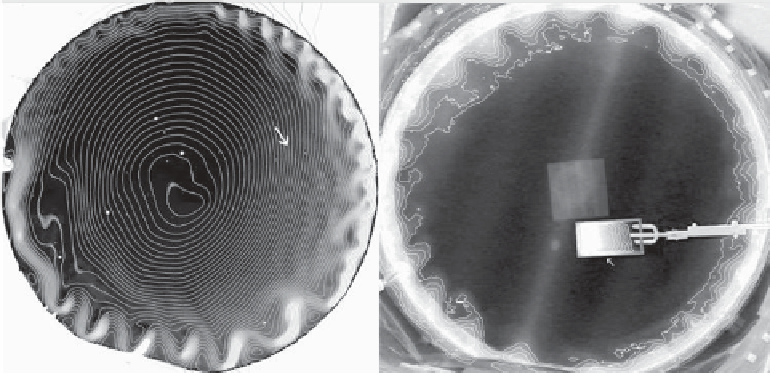Geoscience Reference
In-Depth Information
the flow is wave dominated, in many cases exhibiting a pat-
tern of zonal flows (jets). Some examples of baroclinic
flows where jets are developed are given by
Slavin and
Afanasyev
[2012].
Let us now return to the problem of emission of inertial
waves. Inertial waves provide a mechanism of adjustment
of rotating flows. They can also be viewed in the con-
text of so-called spontaneous emission. The idea behind
this is that a balanced flow should exist without any sig-
nificant emission of inertial waves. Balanced flow is the
vortical flow that can be described by an appropriate bal-
ance relation such as a geostrophic or quasi-geostrophic
relation. Inertial waves are filtered out from these relations
and assumed to be negligible. By relaxing the original
restrictions of the model, one can obtain source terms
on the RHS of the balanced equations.
Lighthill
[1952]
derived the source term for acoustic sound generation by
turbulence in a compressible fluid.
Ford
[1994] derived
a similar term for the more geophysically relevant prob-
lem of emission of gravity waves in a rotating shallow
water system. However, it is not yet completely clear
what the most favorable circumstances for wave emis-
sion are and how much energy is radiated in the emis-
sion events. A few laboratory experiments reported in
the literature demonstrate that wave emission does occur
in different circumstances, although the percentage of
radiated energy is quite small. For example,
Lovegrove
et al.
[2000] and
Williams et al.
[2005] reported observa-
tions of inertia-gravity modes in baroclinically unstable
rotating two-layer flows.
The emission of interfacial gravity waves by interact-
ing vortex dipoles in a nonrotating two-layer fluid was
demonstrated by
Afanasyev
[2003]. It was shown that for
an effective emission a match between the speed of the
translating vortex structure (dipole) and the phase speed
of the wave as well as a match between the size of the
dipole and the wavelength of the wave is required. Here we
briefly review the results of experiments where the emis-
sion of pure inertial waves by baroclinically unstable flows
was observed in the rotating fluid [
Afanasyevetal.
, 2008b].
In those experiments, the flows were induced by a small
source of fresh water located on the surface of a saline
layer at the wall of the tank. The fresh water from the
source forms a coastal current that is wedge shaped in
cross section. The current is approximately in geostrophic
balance. A jet of width equal to the baroclinic radius of
deformation forms at the outer edge of the current where
the density interface intersects the surface forming a den-
sity front. The current is leaning on the wall to its right
such that the Coriolis force is directed toward the wall. For
further details on the dynamics of coastal density currents
in the rotating fluid, the reader is referred to the review by
Griffiths
[1986].
The freshwater coastal current however rapidly suc-
cumbs to the frontal/baroclinic instability, which results
in the formation of typical meanders along the current
(Figure 5.7). Meandering coastal currents are a familiar
phenomenon; they can often be observed in the satellite
images of the ocean. The dynamics of finite-amplitude
meanders is quite complicated. The meanders grow and
(a)
(b)
1
Figure 5.7.
Meandering coastal current induced by a source of fresh water on the surface of a saline layer. (a) Isolines of surface
topography superimposed on the altimetric image of the flow. The height difference between the adjacent isolines is 80
μ
m.
Inertial waves are emitted by the baroclinic meanders. They are visible in the area between 2 and 4 o'clock (indicated by the
arrow) and propagate in the unstratified interior of the tank away from the coastal current. (b) Isolines of density interface depth
obtained by optical density method in a separate experiment. The contours of depth are from 0.8 to 3 cm with the interval of
0.4 cm. The current is colored by red food dye. The original color image is converted to gray scale. A wedge-shaped cuvette
(1) is used for calibration of the optical density measurements.
















